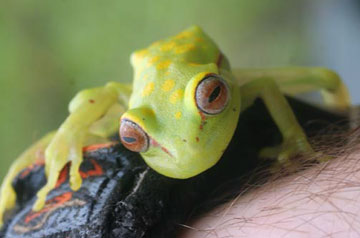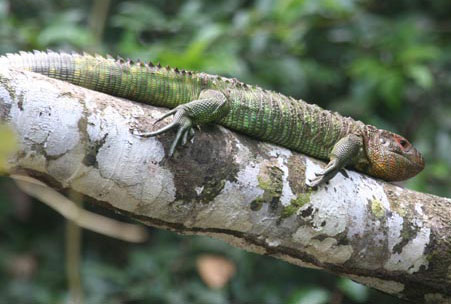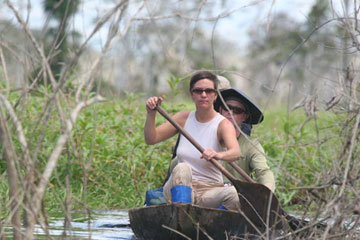Special to mongabay.com: Wilderness Classroom: Expedition 2006 The following is an update from The Wilderness Classroom’s expedition to the Peruvian rainforest. You can follow their adventures at wildernessclassroom.com |
Can we save the rainforests? Lessons from the Amazon
The Wilderness Classroom Organization
May 5, 2006
Update 17: Team work helps everything survive – Dave
When I think back over the last month, dozens of images come to mind. I am reminded of the many things we have learned during Project Peru 2, and the challenges that our team has overcome with your guidance and help. In a way all of the plants and animals in the rainforest rely on each other to survive in the same way that Warren, Ruben, Anna, Patrick, and I rely on each other.
If you removed any member of our team, the rest of us would suffer. We have developed a system of team work and respect for each other. We have learned that the small things keep us working together as a team. Thanking someone for cooking dinner, telling others they are doing a good job, and sympathizing with a team member when they have had a hard day strengthens the bonds between us that ensure our survival.
The plants, animals, and peopleof the rainforest also rely on each other to survive. They build relationships, and require knowledge, resources, and skills necessary to maintain the delicate balance that allows thousands of different species to survive in the Amazon Rainforest. If a large section of forest is destroyed, or a species becomes extinct, it affects all of the other plants and animals in the forest.
The keys to keeping the forest healthy are knowledge and practice: just like working as a team. Getting to know my fellow team members has allowed me to learn their strengths and weaknesses, and figure out how they fit into our team. The more we practice working together, the stronger we become, which allows us to tackle even greater challenges.
 The small animals, like this polka dotted tree frog are a constant reminder of the biodiversity found in the flooded forest. |
The rainforest has learned how to maintain a healthy balance over thousands of years of trial and error. We need to learn as much as we can about the forest, so that we know how to help protect the plants, animals, and people that live there. We also need to work to protect large sections of rainforest so that the plants and animals have places, or habitat, to maintain the intricate relationships, which allow the forest to thrive.
I plan to continue to learn more about the flooded forest, and will work hard to raise awareness about this irreplaceable ecosystem. I hope that you will also continue to learn and explore this amazing place.
What can you do to continue to learn about and protect the Amazon Rainforest?
Animals of the Amazon – Patrick
 A Green Caiman Lizard suns itself on a tree over the river. They eat insects, fruits and turtle eggs. |
We have seen tons of cool animals in the Peruvian rainforest. The great wealth of sun, water, nutrients and fresh air has made the Amazon rainforest alive with more life than any other place on earth. But life is not easy in the jungle; it is a world of endless life-or-death competition for survival. Trees and plants compete for sunlight and soil, while monkeys and macaws compete for the trees’ fruits. The constant pressures of survival have made life forms develop unique natural advantages or specialized adaptations.
It seems as though every living organism in the jungle is highly adapted and most species are interdependent (known as mutualism). This means that they create a relationship where they help each other survive. For example, fire ants protect the Cecropia tree from vines and predators, and in return receive a perfect nest site. During the flood, many trees rely on certain fish to eat their fruit and at the same time, the fish disperse the plant’s seeds for the coming dry season.
Several fish species have developed pectoral fins that they can use to walk across the forest floor when the floodwaters return to the river channel. The flexible river dolphins use sonar to locate their prey. Fish and many insects use their sense of smell to find food sources. Birds use keen senses of sight and hearing. Some animals, like monkeys, are arboreal (living in the trees); they use natural highways over 100 feet above ground. Arboreal animals have developed great balance, strong hands, feet or claws, and some use a prehensile tail as another way to hold on.
Pacaya Samaria National Reserve is a very bio-diverse region- meaning many different species of living things live there. Thanks to the help of our guides, Ruben and Warren, we’ve seen and recorded over 150 species of mammals, reptiles, birds and insects in the Pacaya Samaria. Keep in mind the most common defensive tactic, used by most animals in the rainforest, is simply to hide- so we were probably seen by many more creatures than listed here.
How do people survive in the flooded forest – Anna
It has been a great honor spending time with the strong, humble, and resourceful people of the Amazon. We have learned so much about how they survive in the flooded forest. One common theme holds true in every village: the people that live in the rainforest depend on the land and the rivers for their survival. From the moment they wake up, they gather resources from the rainforest: wood for their cooking fires, papaya, bananas, and other foods from their gardens, and fish from the rivers. They use the valuable yucca root in all forms: fried, boiled, as the main ingredient in bread, and even in beer. They gather their meat from hunting animals such as the monkey, paca, and peccary. They build their houses using rainforest trees such as the mighty kapok and vines such as the tamishi.
The rainforest is their medicine cabinet. People use plants, such as the una de gato to prevent illness and to treat some types of cancer. Wild senna is used to treat fungal infections. During labor, women drink a tea made of coca leaves to stimulate contractions. After the birth of the baby, they drink the sap, or milk, from the capinuri tree to speed up the recovery process. The list of medicinal plants goes on and on.
People must build their only means of transportation, dugout canoes, out of trees from the rainforest. This process takes up to two weeks of hard labor. They wash their dishes, clothes, food, and bodies in the rivers. They gather their water for cooking and drinking from that same plentiful resource: the river.
The way the people in the rainforest live makes sense to me. This massive lowland forest of plants, trees, and animals provides everything the people need to be happy, healthy, and wholesome. They are thankful for all that the rainforest that gives them life.
As I continue on my path, I will carry the countless gifts and lessons that my new rainforest friends have given me. Thank you great forest for providing for us, and thank you friends for bringing me back to the Earth.
Can we save the rainforests? Patrick, Anna, and Dave
 Anna and Patrick started this adventure with very little knowledge of how the Wilderness Classroom worked, or what their roles would be. They proved to be fast learners and great team players. |
Rainforests all over the world are disappearing rapidly. In fact, many experts believe that rainforests are shrinking at a rate of one hundred acres per minute. That number seems hard to believe for most of us. But I am sure if we asked the plants and animals whose habitats are shrinking daily, they would tell a similar and very sad story.
We have learned about the many reasons for the disappearing rainforest, and sadly,they can all be blamed on humans. As we know now, the Amazon is full of thousands of desirable plants, trees, and animals. Many people will go to great lengths to get these things. Many pharmaceutical companies are in hot pursuit of tropical plants for modern medicines. Many do not harvest the plants sustainably, which won’t allow the plants to continue to thrive. Illegal loggers after valuable wood are not uncommon. They will cut down entire areas of rainforest for the motive of money. The constant quest for oil leaves nothing but mounds of mud in places where monkeys and birds once lived. With the logging, oil, and pharmaceutical industry, comes building roads that further destroys the rainforest.
If the rainforests are to survive, there must be cooperation between the countries that are home to the forests and the companies that want the natural resources, like plants and trees. But how do they do this? How do we still use the valuable gifts from the rainforest without destroying it while doing so? Unfortunately, this complicated dilemma will continue until more aggressive action is taken to preserve our rainforests: the lungs of the earth.
Track the adventurers at wildernessclassroom.com